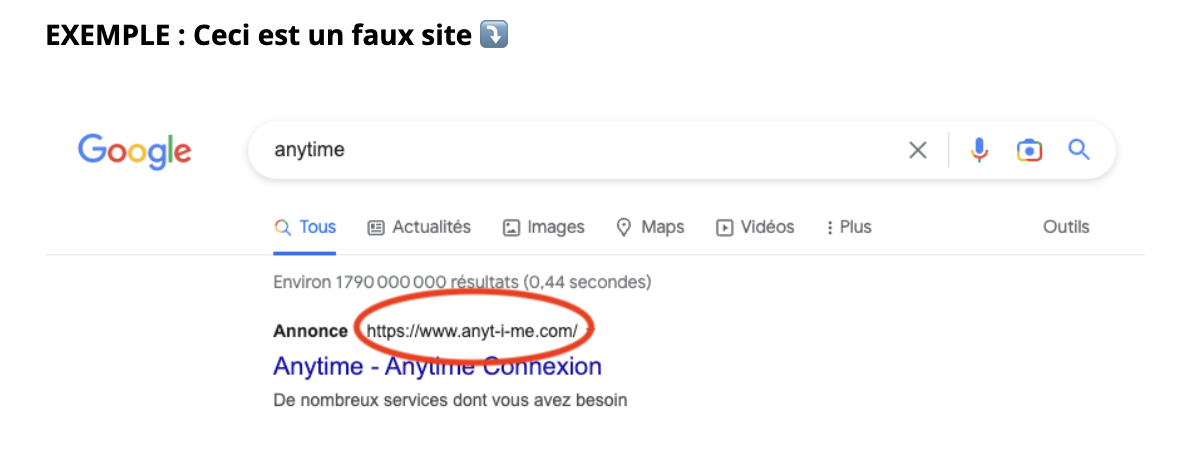Depuis peu, les campagnes de phishing se multiplient autour des services bancaires. Dans ces pratiques, les fraudeurs se font passer pour un organisme connu de l’utilisateur (CAF, Assurance Maladie ou encore banque).
Lorsque vous cherchez “Anytime”’ sur votre moteur de recherche, il se peut que vous soyez confronté à de faux sites internet (particulièrement en haut des résultats). Souvent, ils reproduisent entièrement l’interface d’Anytime, soyez donc particulièrement vigilant !

Comment s’assurer que vous êtes sur le bon site ?
Si vous passez par un moteur de recherche, vérifiez que l’adresse URL qui s’affiche est à la lettre près https://www.anyti.me/ et enregistrez cette URL dans vos favoris.
Ensuite, utilisez le bouton “Se connecter” pour vous connecter à votre compte. C’est l’unique manière de vous garantir une connexion sécurisée à votre compte.
Voici d’autres précautions qui pourront vous permettre de vous assurer d’être sur un site sécurisé :
- Vérifiez que le site dispose d’une sécurité “https”.
- Si vous effectuez une action bancaire, assurez-vous que la transaction est protégée. Un petit cadenas doit être présent sur la ligne de l’URL.
- Privilégiez toujours la double authentification (méthode d’authentification forte qui demande deux preuves d’identité distinctes) ou la SCA (qui vérifie l’identité du client avant de confirmer un achat).
- Installez des antivirus afin de limiter les risques.

Identifier les phishings
Courriers électroniques, SMS, site web… il existe aujourd’hui de nombreuses formes de phishing. Ces communications semblent être envoyées par votre banque ou un autre organisme connu.
Elles vous invitent principalement à :
- cliquer sur un lien,
- remplir un formulaire,
- communiquer vos données bancaires.
Vous souhaitez vérifier qu’un mail vient bien d’Anytime ? Il vous suffit de vous assurer que la fin de l’adresse mail de l’expéditeur est “@anyti.me”. En cas de doute, n’hésitez pas à contacter nos équipes.
Les bonnes pratiques à adopter dès maintenant :
- Ne jamais répondre à ces communications frauduleuses
- Ne jamais cliquer sur les liens présents dans des messages douteux
- Ne jamais communiquer vos identifiants et mots de passe
- Ne jamais communiquer des informations confidentielles
- Nous contacter immédiatement si vous avez le moindre doute
Sachez qu’Anytime ne vous enverra jamais de message vous invitant à communiquer à nouveau vos identifiants ou des données personnelles de connexion.
Si cela arrive, attention, il s’agit probablement d’une tentative de fraude.
Que faire si vous pensez être victime de phishing ?
Voici les premiers réflexes à adopter quelle que soit la forme que prend l'arnaque que vous avez identifiée :
- Modifiez immédiatement vos codes confidentiels. Choisissez un mot de passe fort et unique pour chaque site.
- Contactez au plus vite notre service client, via notre Chat par exemple
- Fermez votre session et quittez totalement votre navigateur. Vous pouvez ensuite vous reconnecter avec votre nouveau mot de passe.
- Si vous constatez des activités anormales : signalez-le à nos équipes. Nous prendrons contact avec vous pour vous indiquer la marche à suivre.
Si vous êtes sûr d’être victime de phishing : faites opposition immédiatement.
Le site officiel du gouvernement recommande de conserver les preuves (comme le message d’hameçonnage reçu) et de déposer plainte.
Pour ces démarches, vous pouvez vous faire accompagner gratuitement par l’association France Victimes au 116 006 (appel et services gratuits) 7 jours sur 7 et de 9h à 19h.
N'hésitez pas à consulter le site du gouvernement dédié à la prévention contre le phishing pour plus de renseignements : https://www.cybermalveillance.gouv.fr/tous-nos-contenus/actualites/dossier-phishing
Les bonnes pratiques pour sécuriser ses comptes en ligne
Pour prévenir au maximum les risques de piratage en ligne, il existe de nombreuses astuces simples à appliquer au quotidien. Bonne gestion de vos mots de passe avec une application sécurisée, choix de sa connexion internet, vérification des adresses URL, vous pouvez retrouver tous nos conseils ici.